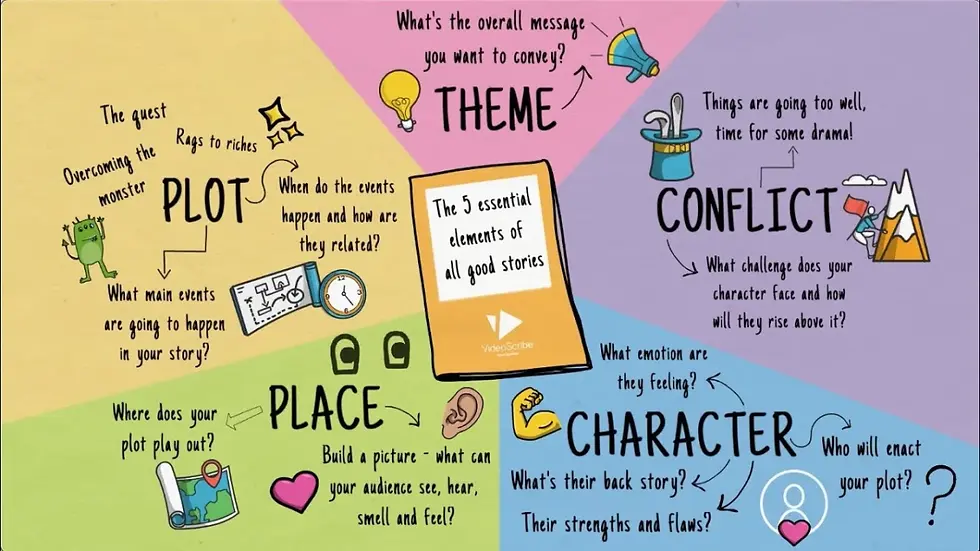Bringing Characters to Life: Putting It All Together in Your Scripts
- khailareyno
- Apr 25, 2024
- 7 min read
Updated: Apr 30, 2024

Now, let's bring it all together and summarize everything!
In this blog series, we explored the intricate world of nonverbal communication and its profound impact on character development and storytelling. We began by understanding the language of the body, delving into facial expressions, gestures, and posture. We then applied these concepts to writing, analyzing how nonverbal cues can enhance dialogue and convey emotions authentically.
We emphasized the importance of understanding human behaviour as a foundation for creating compelling characters, highlighting the role of nonverbal communication in relationships and the power of silence in storytelling. We also discussed how different genres utilize nonverbal cues and analyzed iconic movie scenes to understand their impact.
Throughout the series, we encouraged writers to observe nonverbal cues in real life and translate them into their writing, emphasizing the need for authenticity and balance between verbal and nonverbal communication. Finally, we explored the unspoken secrets of character development, emphasizing the importance of depth, consistency, and transformation in creating memorable characters that resonate with audiences.
Here's a concise summary of key elements to include in your story:
Understanding Your Characters
Understanding your characters is the foundation of creating compelling stories. Before you start writing, take the time to fully immerse yourself in their world. What are their motivations, fears, and desires? What drives them to act the way they do? Delve into their backstory to uncover the events and experiences that have shaped them into who they are. The more you know about your characters, the more authentic and believable they will feel on the page.
Nonverbal cues play a significant role in understanding your characters' inner workings. These cues, such as body language, facial expressions, and gestures, provide valuable insights into their thoughts and emotions. By paying attention to these cues, you can add depth and complexity to your characters, making them more relatable to your audience. Delving into a character's backstory through nonverbal cues can reveal hidden layers of their personality and motivations, making them more multidimensional and realistic.
Incorporating nonverbal cues into your writing can also help you create more vivid and engaging scenes. Instead of just telling your readers what your characters are feeling, show them through their actions and expressions. This not only makes your characters more lifelike but also helps to immerse your readers more fully into the world you've created.
Creating Depth
To avoid creating one-dimensional characters, it's essential to give them depth and complexity. This means ensuring they have a range of traits, including strengths, weaknesses, and quirks, that make them feel like real people. Consider how their past experiences have shaped them and how these experiences influence their actions in the present.
Nonverbal cues are instrumental in adding depth to characters. They provide subtle hints about a character's personality, motivations, and emotions, enriching their portrayal. For example, a character's body language, such as a nervous habit or a confident posture, can reveal aspects of their personality that are not explicitly stated in the dialogue. These cues help to make characters more nuanced and realistic, engaging the audience on a deeper level.
Additionally, consider how a character's past experiences have influenced their nonverbal communication. Traumatic events, for example, may manifest in certain gestures or expressions, adding layers to their characterization.
Consistency
Consistency in characters' actions and dialogue is crucial for believability, and nonverbal cues play a significant role in maintaining this consistency. These cues provide a visual representation of a character's traits and behaviours, ensuring that their actions align with their established personality.
For example, if a character is portrayed as cautious and risk-averse, their body language and facial expressions should mirror these traits. They might display signs of hesitance or anxiety in risky situations, such as avoiding eye contact, fidgeting, or speaking in a hesitant tone. If the character were to abruptly engage in reckless behaviour without a convincing explanation, it would contradict their established traits and disrupt the audience's immersion.
Dialogue
Using dialogue effectively is key to revealing your characters' personalities and relationships. Each character should have a unique voice that reflects their background and personality. Pay attention to the way they speak and interact with others, as this can provide valuable insight into who they are.
Nonverbal cues, such as body language and facial expressions, play a crucial role in enhancing dialogue. They add subtext and nuance, revealing hidden emotions or intentions that may not be explicitly stated in the dialogue. These cues can add depth to the characters' relationships and interactions, making them more dynamic and engaging.
For example, consider a scene where two characters are having a conversation. One character may be saying one thing, but their body language suggests something entirely different. Perhaps they avoid making eye contact or fidget nervously, indicating that they are not being entirely truthful. This discrepancy between their words and their actions adds complexity to the scene, making it more compelling for the audience.
Don't forget to revisit "Mastering Character Dialogue: Balancing Verbal and Nonverbal Communication" for further insights on this subject!
Relationships
In crafting compelling characters, their relationships with others play a crucial role, shaping their development and driving the narrative forward. By illustrating how characters interact with one another, writers can provide insight into their personalities and motivations. Strong relationships, whether positive or fraught with tension, can add layers to characters, making them more relatable and compelling to audiences.
Nonverbal cues are crucial in portraying these relationships authentically. A simple gesture, a fleeting expression, or a shift in body language can convey a wealth of emotions and intentions. For instance, a character may show affection by touching another character's arm, or they may express frustration through a clenched jaw or furrowed brow. These cues add depth and nuance to the characters' interactions, making them more dynamic and believable.
Additionally, nonverbal cues can reveal the underlying dynamics of a relationship. A character who avoids eye contact or stands at a distance from another may indicate a lack of trust or closeness. Conversely, characters who mirror each other's movements or maintain close physical proximity may suggest a strong bond or connection.
Symbolism
Symbolism is a powerful tool in storytelling, allowing writers to imbue their characters with deeper meaning and significance. This can be achieved through various elements such as names, physical appearance, or the roles they play in the story.
For a more in-depth understanding of this element, revisit the chapter "Character Development: Unspoken Secrets in Crafting Memorable Characters."
Transformation
Memorable characters often experience significant transformation or growth as they progress through the story. This transformation can take various forms, such as a positive change where they overcome their flaws and achieve their goals, or a negative change where they descend into darkness or despair. Regardless of the direction, this transformation should be meaningful, impacting not only the character but also the overall trajectory of the story. It serves to add depth to the character's journey, allowing them to evolve in response to the challenges they face and the lessons they learn along the way. This transformational arc is crucial for creating dynamic and compelling characters that resonate with audiences long after the story ends.

When transitioning your script to the screen, consider the following points if you're planning to create a screenplay:
Action Beats
Action beats are like punctuation in screenwriting. They serve as pauses between dialogue, allowing the audience to digest what has been said and providing a moment of reflection. These beats are crucial for pacing and rhythm, helping to maintain the flow of the scene.
Action beats can reveal a character's inner thoughts and feelings, revealing emotions, intentions, and reactions through their physical movements. By incorporating action beats, writers can elevate the emotional impact of a scene, creating a more immersive experience for the audience. For example, a character who nervously taps their foot while lying might betray their deception through this action, adding tension to the scene.
When writing action beats, it's important to be concise and specific. Too much detail can slow down the pace of the scene, while too little can make the action unclear. Finding the right balance is key to effectively conveying the character's emotions and intentions.
Writing Story Beats That Advance Your Script Like A Pro \ Getfilming
Reactions
In screenwriting, characters' reactions serve as a window into their inner worlds, offering insights into their personalities and driving forces. These responses to external stimuli can be subtle gestures, intense emotional displays, or nuanced changes in behaviour, all of which add depth and authenticity to their portrayal.
I've covered this topic in several chapters, so be sure to revisit them for a more comprehensive understanding of character reactions.
Environment
The environment in which a scene unfolds is more than just a backdrop; it's a crucial element that sets the stage for the characters' actions and interactions. Describing the environment in your screenplay not only helps establish the mood and tone of the scene but also provides context for the characters' behaviour.
Imagine a scene set in a dimly lit, cluttered apartment. The details of the environment—the dim lighting, the cluttered space—can convey a sense of isolation or unease, influencing how the characters interact. Similarly, a scene set in a bustling city street with bright lights and bustling crowds can evoke a sense of energy and excitement, affecting the characters' emotions and actions.
Silence
Silence is more than just the absence of sound; it's a powerful storytelling tool that can convey a range of emotions and add depth to your screenplay. When used effectively, silence can create moments of tension, reflection, or emotional impact that resonate with your audience.
Incorporating moments of silence into your screenplay allows you to create space for your characters to process their thoughts and emotions, adding realism and depth to their interactions. For example, a scene where two characters share a meaningful look without saying a word can be more impactful than a scene filled with dialogue. Silence can also be used to build suspense or anticipation, as the absence of sound can create a sense of unease or anticipation for what will happen next.
When writing silence into your screenplay, consider the pacing and rhythm of the scene. Use silence to punctuate key moments or to create a pause for dramatic effect. Pay attention to the visual elements of silence as well, such as facial expressions, body language, and camera angles, as these can enhance the emotional impact of the scene.
Here's a final video to conclude our discussion!
Mastering the art of incorporating nonverbal cues into your screenwriting can elevate your storytelling to new heights. By paying attention to the subtle gestures, expressions, and movements that reveal the inner workings of your characters' minds, you can create rich, multidimensional characters that resonate with your audience. Nonverbal cues add depth and authenticity to your scripts, helping you craft compelling narratives that captivate and engage viewers. So, next time you sit down to write, remember the power of the unspoken, and let nonverbal cues enhance your screenwriting journey.
Now that you've gained valuable insights on your journey with me, it's time to further hone your skills in identifying nonverbal cues. Explore the activity section of this website for practical exercises and challenges to enhance your understanding. Now, let's begin writing!


